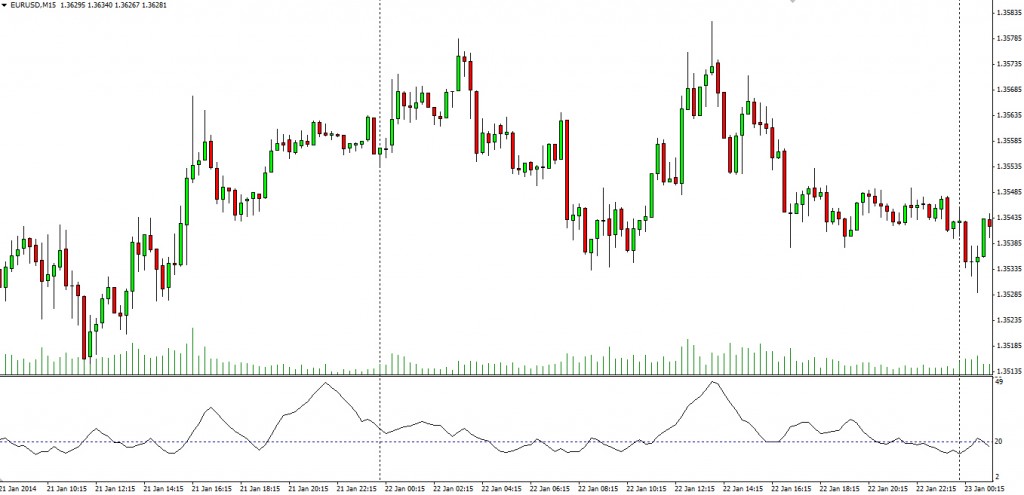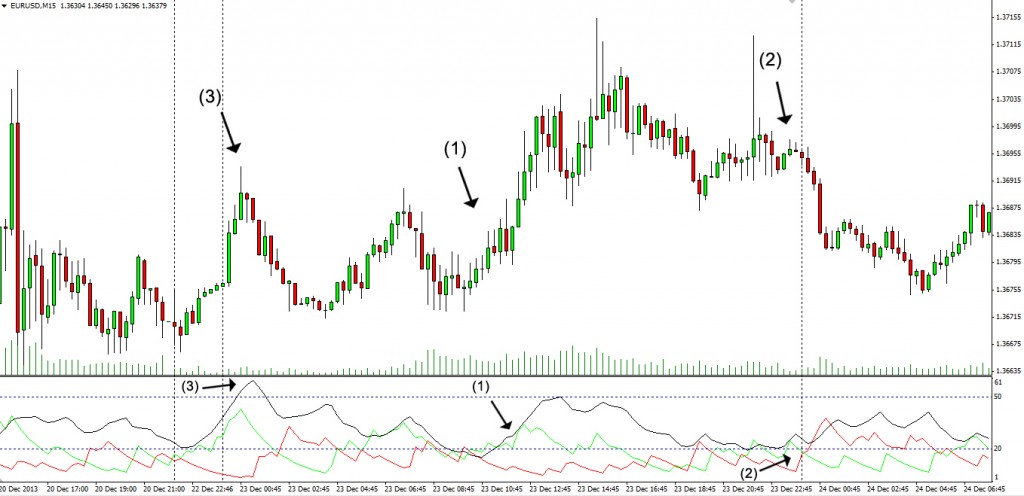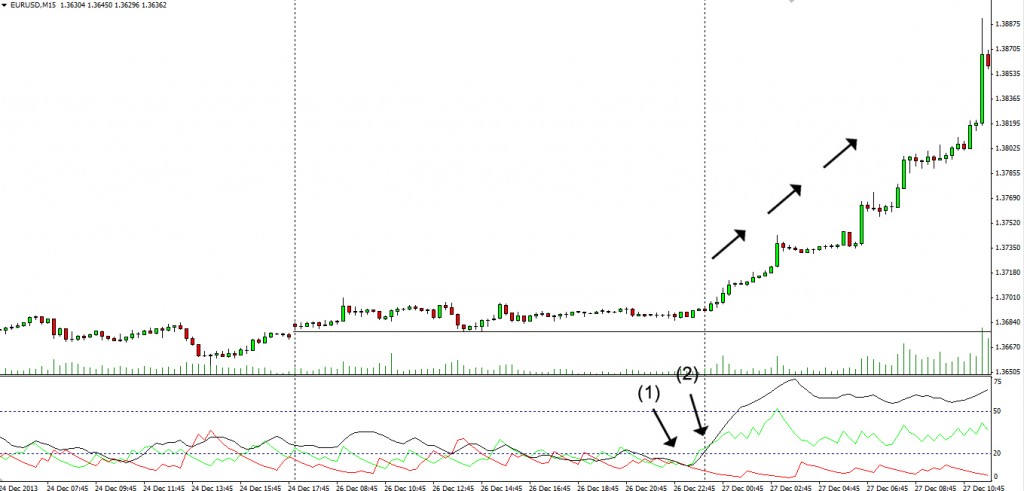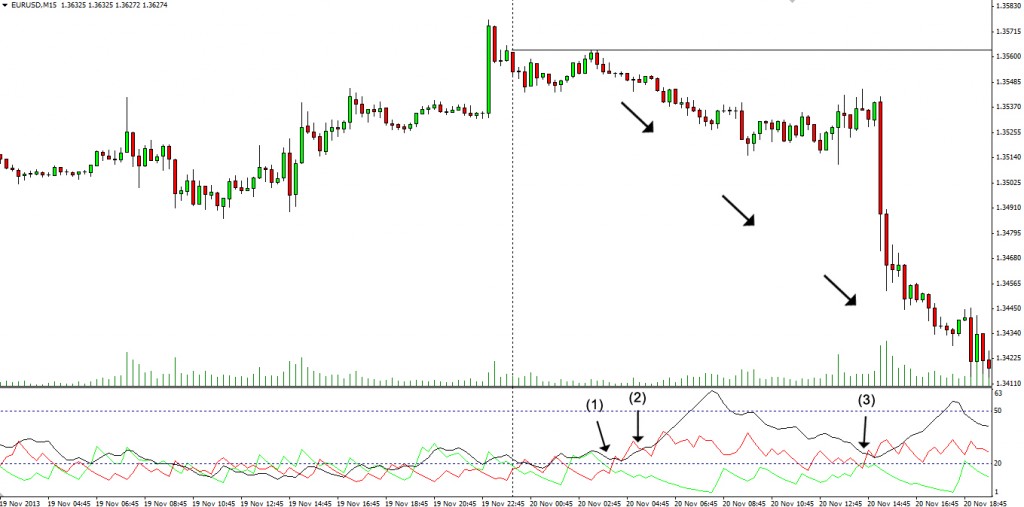Average Directional Movement Index
This lesson will cover the following
- What is ADX
- What does it tell us
- Positive Directional Indicator and Negative Directional Indicator – the backbone of ADX
- What signals does their combination generate
The Average Directional Movement Index, or also known as ADX, is a trending indicator developed by J. Welles Wilder and is used to determine a trends strength. It consists of a single line and is derived from the Directional Movement Index, which itself consists of two indicators – Positive Directional Indicator and Negative Directional Indicator (or +DI and -DI).
What is specific about the Average Directional Movement Index is that it does not point out the direction of the trend, rather its strength, and its main purpose is to estimate the different phases of that trend. You can see on the screenshot below that the ADX alone tells you nothing more but how strong the price momentum is.
The calculation of the Average Directional Movement Index is relatively complex and is done in several steps, so for now its sufficient to say that this indicator is always positive and ranges in a scale between 0 and 100. Values however rarely exceed the level of 60 and 20 is considered as a key point distinguishing trending from ranging markets. The higher the ADX is, the stronger the trend is considered to be.
The Average Directional Movement Index has only one parameter, which could be tuned by the trader – the number of periods, in which prices will be tracked back. As with moving averages, the greater the historical period looked upon is, the smoother the ADX line will be but also the more rarely it will show significant moves.
When the ADX falls below the 20 area, it indicates that the market is not trending, rather moving sideways. If the value jumps above 25, this means that the market is heading in a certain direction. If the indicator rises further above 30 towards the 40-50 area, it confirms that we have a strong trend in motion, while values dropping below 30 from above suggest that the current trend is losing momentum and a price reversal is likely. This might be considered as an early sign that we should consider gradually closing our positions.
Rarely used by itself
Chartists however rarely use ADX alone, rather combine it with the two directional movement indicators – Positive Directional Indicator and Negative Directional Indicator. The latter two complement the ADX by showing the direction of the trend, thus allowing the combination of the three to present both the direction and the strength of the trend. The following screenshot illustrates how -DI, + DI and ADX are used together.
The set of directional movement indicators provide us with several hints.
First, when one of the DIs is above the other, the market trend is in that direction, as seen at (1).
Second, when the two DIs meet with each other, it suggests that the market is currently trading sideways and that a trend is close to being formed, as seen at (2).
Third, a DI reaching an extreme level, as seen at (3), is often considered a predecessor to a trend reversal, or at least to a slowdown, thus presenting you with an early sign for exiting your position.
Basic explanation of calculation
But what determines the positive or negative movement? When a certain periods high exceeds the high of the previous period, we have positive directional movement. If however the days low is less than the previous days low, we have negative directional movement. If the latest periods range is completely engulfed by the previous one, it is ignored. In the opposite scenario, when the latest days range completely engulfs the previous ones, the greater difference wins. All these four cases are illustrated below.
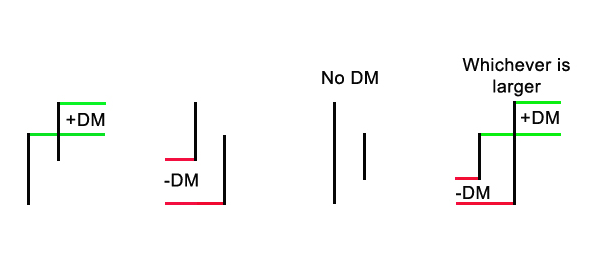
Having gone through some relatively complex calculations, which we will refrain from explaining just yet, you end up estimating the -DI and +DI values. By using these two indicators, we can create the Directional Index. It is calculated by taking the absolute difference between the values of the -DI and the +DI and dividing it by their sum. Note that the absolute difference is used, which is where the ADX derives its constant positive value.
After weve determined the DX, we can now smooth its value, thus creating the ADX. If, for example, we are using a 14-day ADX, the first ADX is simply a 14-day average of the Directional Index. Having explained the basics of the calculation, you can see what the link between the -DI and +DI and ADX is.
Useful for trend spotting
The Average Directional Movement Index is particularly useful to determine when to use a trend-following moving average system. As we know, moving averages are profitable when the market is trending, while sideways trading leads to whipsaws in moving average systems. It is then wise to first confirm that there is a strong directional trend before using moving averages to generate buy and sell signals.
Another hint worth considering is that when the ADX peaks above both the DMIs, it often signifies a high in the trend. Logically, low levels in the ADX signal trendless periods, which are usually followed by dynamic market movement.
Generally, a buy signal is generated when the +DI crosses above the -DI and the ADX holds above the 20 level, while an exit signal should be considered when the ADX drops below 30 from above. Wilder suggests that the minimum ADX level for entry should be 25, but many traders however use 20 as the key level as it produces more possible signals. When entering a long position, Wilder suggests that a stop-loss should be placed on the low of the signal day, depending on what time-frame you are trading. It would also be wise to actually place the protective stop several pips below the support, so that random noise or an attempt to break the days low doesnt trigger it. Even if the +DI crosses below the -DI, you shouldnt abandon the signal until that protective stop is triggered. If the trend develops further in your favor, you should also incorporate a trailing stop.
You can see on the screenshot below that after the market had kept in a narrow range for a day, the ADX plunged to as much as 15. This extreme level is a possible sign that a strong trend might form in the near future, as it actually happened.
At (1), the +DI crossed over the -DI, thus giving us a signal to buy, if the trend accelerates. As soon as the ADX jumped above the 20-level and continued to move towards 30, at (2), a confirmation was at hand that, at least at that moment, a relatively strong trend had formed and further momentum growth is highly possible. This would be a wise moment to enter a long position and place a protective stop at the low of the signal day. Dont forget to use a trailing stop, if the trend develops in your favor.
Logically, a sell signal is generated when the -DI crosses above the +DI and the ADX line is above 20. An exit from your short position should be taken when the ADX falls down below 30. Wilder suggests that a stop-loss should be placed at the the high of the day when the signal was generated, but again, that depends on the time-frame.
You can see on the picture above a similar to the previously illustrated situation, but with the opposite trend. We have a crossover at (1), followed by a trend acceleration at (2), around where we enter a short position and place a protective stop at the days high. It would also be wise to place the protective stop several pips away from support, so that random noise or an attempt to break the days low doesnt trigger it.
As the price action moves in our favor, we place a trailing stop, which would diminish the negative effect of a price reversal. You can also see that the -DI met with the +DI at (3), but in our case this didnt precede a trend reversal, which our trailing stop would have protected us from anyway.
